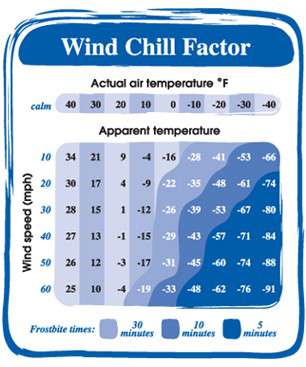
I just heard my friends at Good Morning America say, “It’s 4 below zero outside … with the wind chill.”
We’ve heard about the Wind Chill Factor since we were kids, but what exactly is it? Here’s a look at the new and improved wind chill chart and formula.
Kids waiting for the school bus, college students walking across campus, salesmen hiking from their cars to businesses, shoppers hustling from store to store, we’ve all noticed the impact a strong breeze can have on how cold it feels outside.
Wind acts to steal heat from the human body leading to frostbite and hypothermia.
The Official Wind Chill Formula
From the National Weather Service, here is the new official formula for calculating wind chill:

This formula was implemented in 2001 by the National Weather Service based on research done by several major universities and the U.S. and Canadian Governments. The new Wind Chill Temperature Index uses updated science and technology and new forms of computer modeling to provide a more accurate indication of the impact of wind on how it feels outside. Just in case you’re not up for the fancy math, here is a short version of the official Wind Chill Chart:

If you want a specific reading for your exact temperature and wind speed, check out the National Weather Service Wind Chill Computer. You simply type in your temperature (in Fahrenheit or Celsius) and your wind speed (in mph, knots, meters/second, or Km/h) and it’ll tell you just how cold it feels out there!
Water freezes when the air temperature drops to or below 32 degrees. Wind Chill has no impact on water. Therefore, you don’t need to worry about ice on roads when the temperature is 38 degrees with a wind chill of 25 degrees. Wind Chill also does not impact the type of precipitation which can fall. If the temperature is 40 degrees with a 25mph wind, the Wind Chill Temperature is 29 degrees. That doesn’t mean you’re going to get snow. Instead, it’ll likely be a very cold rain.
A shortfall to the Wind Chill Temperature is that it doesn’t include the impact of sunshine, humidity etc. AccuWeather.com has a patented index called the RealFeel Temperature which takes many more parameters into account. You’ll often see the RealFeel included in AccuWeather’s forecast nationwide.
Stay warm!



